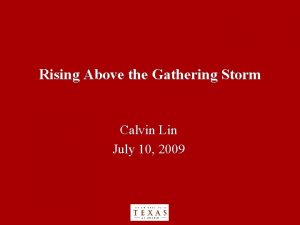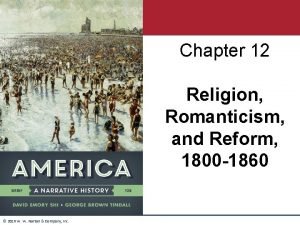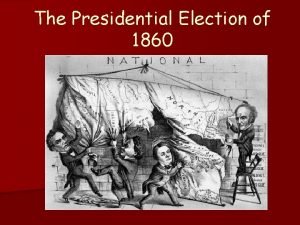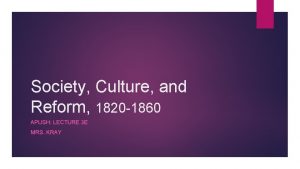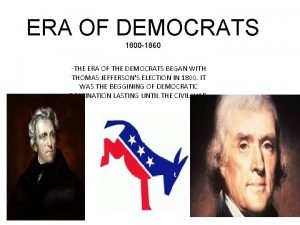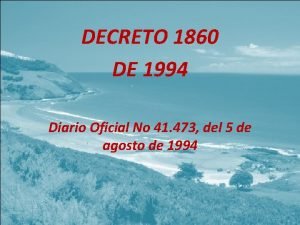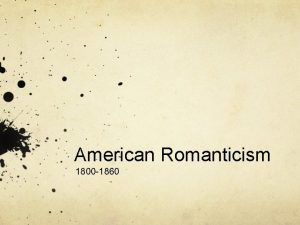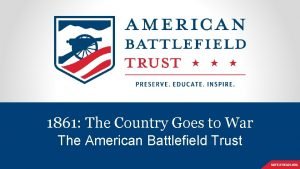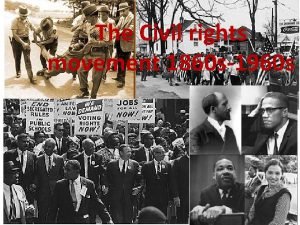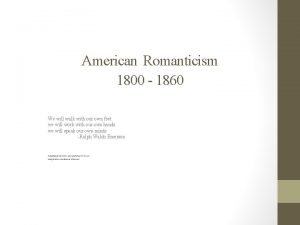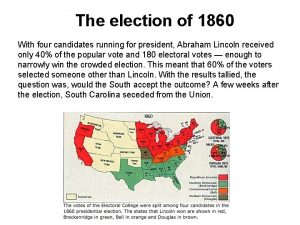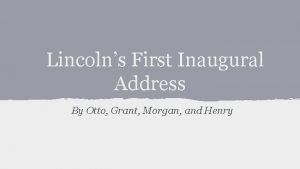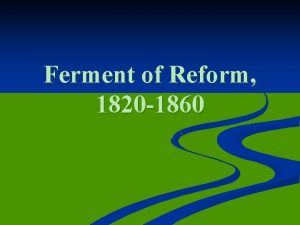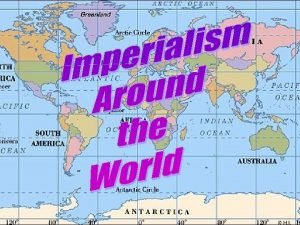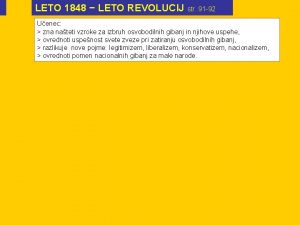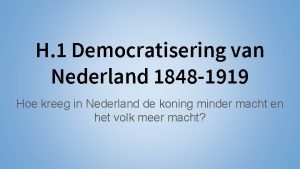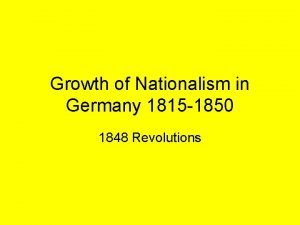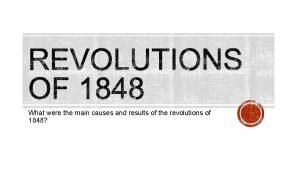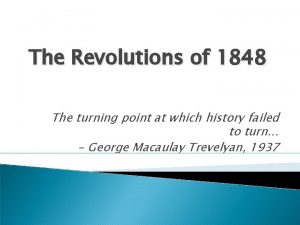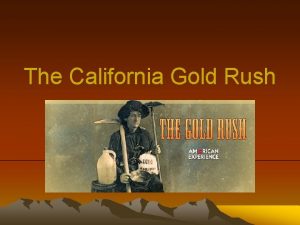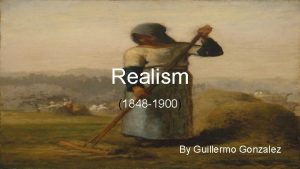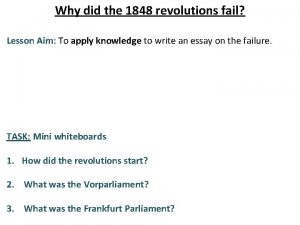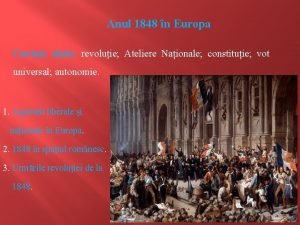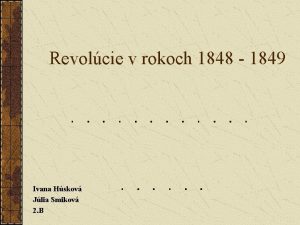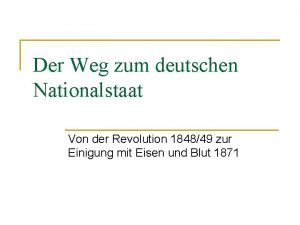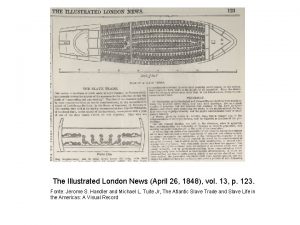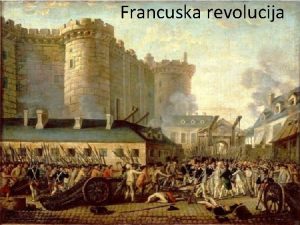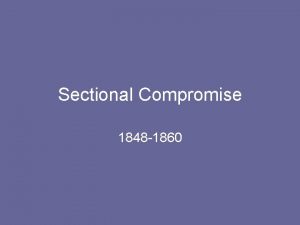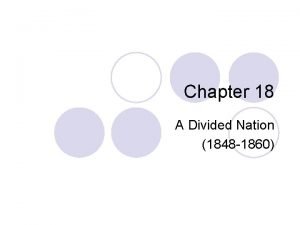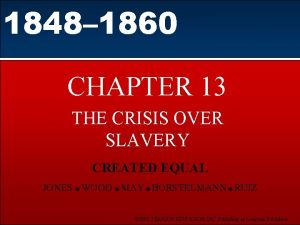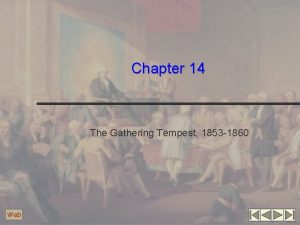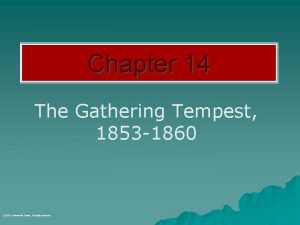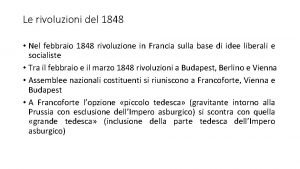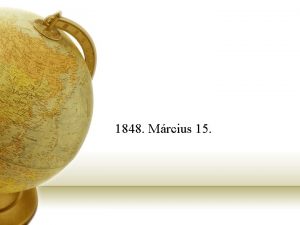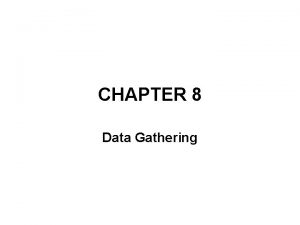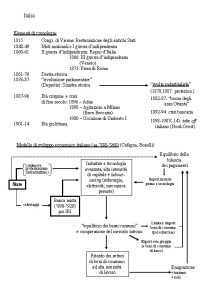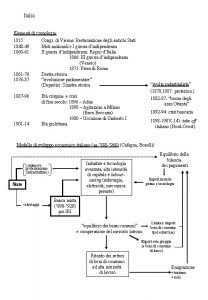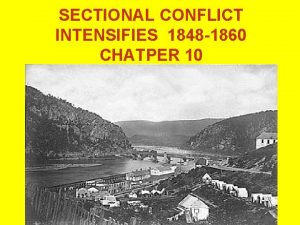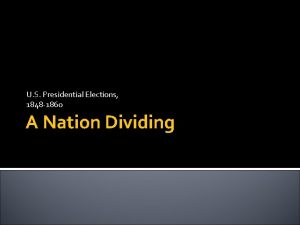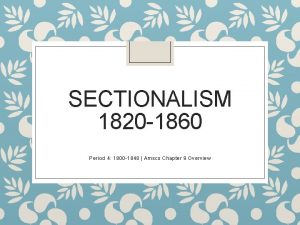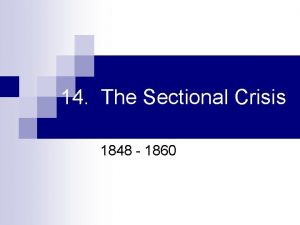Chapter 14 The Gathering Storm 1848 1860 2016









![Life in the Mining Camps There was “a row of canvas tents, [months later] Life in the Mining Camps There was “a row of canvas tents, [months later]](https://slidetodoc.com/presentation_image_h/294ac321869445e4730ed418dd93c18f/image-10.jpg)
































- Slides: 42

Chapter 14 The Gathering Storm, 1848 -1860 © 2016 W. W. Norton & Company, Inc.

Slavery and the Civil War © 2016 W. W. Norton & Company, Inc.

Slavery in the Territories • The Wilmot Proviso • The Missouri Compromise had only extended the slavery line through the Louisiana Territory. • Now, vast quantities of land had been added to the United States, and there existed no provision to delineate slave from free territory. • The Wilmot Proviso, which was never passed, stated that slaves would not be allowed in any land taken from Mexico. • Popular Sovereignty- allow settlers to choose if slavery would be allowed. © 2016 W. W. Norton & Company, Inc.

Slavery in the Territories, continued • The Free-Soil Coalition- made up of northern Democrats, anti-slavery Whigs and Liberty party. • Created in 1840 -Liberty party was a 3 rd group, but had no electoral success. • The California Gold Rush • Due to gold fever, stated quickly gains enough settlers to apply as a state. • California Statehood- New Mexico was also ready to enter and both forbad slavery. © 2016 W. W. Norton & Company, Inc.

The Wilmot Proviso © 2016 W. W. Norton & Company, Inc.

Gold Miners Chines and white workers in 1856 © 2016 W. W. Norton & Company, Inc.

Discovery and the Forty-Niners • First gold discovered on John Sutter’s Mill, by James Marshall in 1848. • After news broke thousands flooded in to attempt to find gold by 1849. • 2/3 of forty-niners were Americans, the rest came from Mexico, South America, Europe, Australia and China. • Most forty-niners were young and male John Sutter © 2016 W. W. Norton & Company, Inc.

Journey to California There were three ways to get to California from United States… 1. Overland- cutting across the country taking routes like the Oregon or Santa Fe Trail. 2. By ship to Panama in Central America, across dangerous jungles to the Pacific side. 3. By ship around the horn of South America © 2016 W. W. Norton & Company, Inc.

San Francisco Travel hub between those traveling by sea to get to California gold country April 1848 population: 850 December 1849 population: 25, 000 • • Major growth Culturally diverse Lawlessness/ fighting Illegal activities © 2016 W. W. Norton & Company, Inc.
![Life in the Mining Camps There was a row of canvas tents months later Life in the Mining Camps There was “a row of canvas tents, [months later]](https://slidetodoc.com/presentation_image_h/294ac321869445e4730ed418dd93c18f/image-10.jpg)
Life in the Mining Camps There was “a row of canvas tents, [months later] there were two thousand men…and the streets were lined with drinking saloons and gambling tables. ” -Luzena Wilson, mining wife at Coyote Diggings camp • Fights over claim boundaries • Often took “justice” into their own hands “In the short space of twenty-four hours we have had murders, fearful accidents, bloody deaths, a mob, whippings, a hanging, and attempt at suicide, and a fatal duel. ” -Louise Clappe © 2016 W. W. Norton & Company, Inc.

Chinese Immigrants Between 1848 -1852 more than 20, 000 Chinese immigrated to California (In 1852, 1 in 10 Californians was Chinese) Originally welcomed by Californians! Once mining became difficult attitudes towards immigrants changed, especially the Chinese. • 1852, state legislature passed law requiring foreign miners to pay monthly fee to mine. • Most immigrants left, Chinese immigrants paid the tax and stayed • Americans began to bully Chinese into leaving (cutting their queues (braids) and burning their shacks) • Many Chinese then left the mines to open businesses or begin farms. © 2016 W. W. Norton & Company, Inc.

The Compromise of 1850 In late 1849, California applied to enter the Union with a constitution preventing slavery, provoking a crisis in Congress between supporters of slavery and abolitionists. According to the Compromise of 1850, proposed by Kentucky’s Senator Henry Clay, California was allowed to enter as a free state, while the territories of Utah and New Mexico were left open to decide the question for themselves. California becomes the 31 st state!! © 2016 W. W. Norton & Company, Inc.

Legacy By 1852 the gold rush was over, in that time 250, 000 people flooded into California. Positive Legacy Negative Legacy • By 1850, California had • Native American population enough people to become dropped drastically from the first state in the far west warfare and disease • Diverse group of both (between 1848 -1870 immigrants and emigrants population went from • Lots of economic 150, 000 to 30, 000) opportunities • Many Californios lost their land to newcomers • Over $2 billion worth of precious metals were extracted during the Gold Rush • $81 million in gold was extracted by 1852 (then $45 million annually through 1857) © 2016 W. W. Norton & Company, Inc.

In the Field Sluice for separation of gold from dirt with water Panning Excavating a river bed after the water has been diverted • Hard, tedious work • Long days (Approximately 16 hours) digging up mud, dirt, and stones while standing knee-deep in icy streams • “The day of quick fortune-making was gone. There are thousands of men now in California who would gladly go home if they had the money. ” –Miner, 1851 © 2016 W. W. Norton & Company, Inc.

The Compromise of 1850 • The Return of Henry Clay- returned to Senate in time to use his skills to prevent Union from tearing itself apart in 1850. • The Great Debate- 8 resolutions • • They were (1) California becomes a free state, (2) New Mexico and Utah would become territories without slaves (3) Texas’s claims of land in New Mexico would not be recognized (4) the federal government would compensate Texas by paying its pre-annexation debts (5) slavery would continue in Washington, D. C. (6) the trading of slaves in Washington, D. C. , would be prohibited (7) adoption of an enforceable fugitive slave act (8) Congress would not be allowed to interfere with interstate slave trading. • Toward a Compromise-President Taylor dies and Millard Fillmore became president. Fillmore was willing to concede on issues to Compromise. • The Fugitive Slave Act- required slaves who had crossed into © 2016 W. W. Norton & Company, Inc. free territory to be returned to their masters.

Clay’s Compromise © 2016 W. W. Norton & Company, Inc.

The Compromise of 1850, continued • • Uncle Tom’s Cabin Written by Harriet Beecher Stowe Detailed the fictional slave life in the South Brought to plight of slaves to a society that ignored it. Published in 1852 and sold 300, 000 copies The Election of 1852 Franklin Pierce elected as president. He tried to appease both sides on slavery and alienated both. © 2016 W. W. Norton & Company, Inc.

The Kansas-Nebraska Crisis • The Gadsden Purchase of 1853 • Douglas’s Nebraska Proposal- Stephen Douglas of Illinois wanted to promote Chicago. • With possible train route west he pushed popular sovereignty to appease the South. • The Emergence of the Republican Party • “Bleeding Kansas” • Elections to create a government were filled with fraud, as voters would come to the area to vote and then return to their home state. • Lecompton and Topeka both push admission to Congress with separate constitutions • The most notable of the events in Bleeding Kansas was John Brown’s Pottawatomie Massacre, which ignited warfare between both sides. © 2016 W. W. Norton & Company, Inc.

• fighting broke out on the morning of May 21, 1856, when several hundred proslavery men entered the town of Lawrence, the center of free-state settlement • the “Sack of Lawrence” inflamed northern opinion; in retaliation, John Brown led a posse to massacre five allegedly proslavery settlers; guerrilla warfare engulfed the territory. © 2016 W. W. Norton & Company, Inc.

© 2016 W. W. Norton & Company, Inc.

Stephen A. Douglas © 2016 W. W. Norton & Company, Inc.

The Kansas-Nebraska Act © 2016 W. W. Norton & Company, Inc.

Kansas a Free State © 2016 W. W. Norton & Company, Inc.

The Kansas-Nebraska Crisis, continued • Violence in the Senate • Senate when Senator Charles Sumner gave his speech, “The Crime against Kansas, ” in which he singled out Senator Andrew Butler of South Carolina as the epitome of the evil slaveholder. • The elderly Butler was not in the Senate that day, but his nephew, Congressmen Preston Brooks, would beat Sumner within an inch of his life on the floor of the Senate for his speech. • Brooks resigned, but was later reelected • Both men would become martyrs for their respective causes. • Brooks becomes symbol of “twisted and violent civilization” © 2016 W. W. Norton & Company, Inc.

III. Realignment of the Party System C. The Election of 1856 1. The Republican platform • revealed that the Republicans had become the Democrats’ main challenger; slavery, not nativism, had become the election’s principal issue; Know-Nothing Party split over the Kansas-Nebraska Act but still managed to nominate Millard Fillmore in 1856; Republicans focused on making every territory free; had written off the South; nominated a political newcomer, John C. Frémont. 2. The Democratic platform • Chose “a northern man with southern principles, ” James Buchanan of Pennsylvania; took refuge in the ambiguity of popular sovereignty and portrayed the Republicans as extremists. 3. Struggle for national power • Democratic strategy helped carry the day for Buchanan, but Frémont did astonishingly well; Republicans carried all but five states north of the Mason-Dixon line; revealed the Democrats were badly strained. © 2016 W. W. Norton & Company, Inc.

The Election of 1856 © 2016 W. W. Norton & Company, Inc.

B. The Dred Scott Decision 1. Scott’s argument • Dred Scott v. Sandford (1857), Scott argued that because his master had taken him to Illinois, a free state, and Wisconsin, a free territory, then according to the Missouri Compromise of 1820, he and his family were free. • • 2. The Supreme Court’s ruling Justice Roger B. Taney, who hated Republicans and racial equality, handed down the Court’s decision: Dred Scott could not legally claim violation of his constitutional rights because blacks were not citizens of the United States, and the laws of Scott’s home state, Missouri, determined his status, and thus his travels in free areas did not make him free; additionally, the Taney court ruled that Congress lacked the right to prohibit slavery in the territories and the Missouri Compromise was therefore unconstitutional (though it already had been voided by the Kansas-Nebraska Act). 3. Curtis’s dissent Scott was a citizen of the United States, because free black men could vote in five states at the writing of the Constitution; since Wisconsin had barred involuntary servitude, a slave’s status would cease to exist entering the territory; the Missouri Compromise was constitutional; resistance to the decision strengthened the young Republican Party. © 2016 W. W. Norton & Company, Inc.

The Lincoln-Douglas Debates • • • 1. The Lecompton constitution in 1857, President Buchanan approved a proslavery constitution (the Lecompton constitution) for the state of Kansas, even though Free-Soilers outnumbered proslavery settlers by at least two to one Douglas broke with the Democratic administration and came out against the proslavery constitution; in doing so, he declared his independence from the South 2. Debating the crucial issues Lincoln challenged the incumbent Douglas to debate him face to face they met in a legendary series of seven debates; Lincoln badgered Douglas with the question of whether he favored the spread of slavery; Douglas worked the racial issue, calling Lincoln an abolitionist and an egalitarian enamored with “our colored brethren”; Douglas won the hard-fought, closely contested election, but the debates thrust Lincoln into the national spotlight. Douglas 5’ 4 and Lincoln 6’ 4 © 2016 W. W. Norton & Company, Inc.

John Brown © 2016 W. W. Norton & Company, Inc.

© 2016 W. W. Norton & Company, Inc.

John Brown- 59 years old. May 24, 1856 - slaughtered 5 in Kansas. Oct 16, 1859 - Brown with 21 men invade Harpers Ferry, Virginia and seize towns armory. John Brown planned to seize a federal arsenal at Harpers Ferry, Virginia, and arm slaves. Thus, an insurrection began against the South. Brown lost both of his sons and was captured by Lt. Col. Robert E. Lee. The Aftermath of John Brown’s Raid 1. Brown’s fate • John Brown stood trial for treason, murder, and incitement of a slave insurrection; he was executed on December 2, 1859. • South viewed North as trying to incite rebellion. • Admirers saw him as a selfless hero. © 2016 W. W. Norton & Company, Inc.

© 2016 W. W. Norton & Company, Inc.

V. The Union Collapses 2. National response denunciation gave way to grudging respect, although most did not advocate bloody slave insurrection; churches marked the hanging with toiling bells, hymns, and prayer vigils; Southerners wondered what they had in common with people who celebrated Brown as a martyr and a Christian hero, rather than a murderer and a robber. B. Republican Victory in 1860 1. Sectional hostility • a southern business convention even called for the reopening of the African slave trade; even the normally routine business of electing a Speaker of the House threatened to turn bloody as Democrats and Republicans battled over control of the office. • • • 2. The Charleston convention they denounced Stephen Douglas and demanded a platform that featured a federal slave code for the territories; the Democrats split; the northern wing nominated Stephen Douglas for president and approved a platform with popular sovereignty. 3. Southern Democrats nominated Vice President John C. Breckinridge and approved a platform with a federal slave code; southern moderates refused to support Breckinridge and formed a new party, the Constitutional Union Party, to provide voters with a Unionist choice. 4. The Republican platform needing to make their platform more broadly appealing, they expanded beyond antislavery, advocating free homesteads, a protective tariff, a transcontinental railroad, and a guarantee of immigrant political rights; Lincoln emerged as the Republican Party candidate for president. 5. Sectional contests in the North, Lincoln faced Douglas; in the South, Breckenridge confronted Bell; after a unprecedented number of voters cast ballots, Lincoln won in all eighteen free states except New Jersey, which split electoral votes between him and Douglas; Breckenridge, running on a southern-rights platform, swept the Lower South plus Delaware, Maryland, and North Carolina. © 2016 W. W. Norton & Company, Inc.

Abraham Lincoln © 2016 W. W. Norton & Company, Inc.

The Election of 1860 © 2016 W. W. Norton & Company, Inc.

“The Union Is Dissolved!” © 2016 W. W. Norton & Company, Inc.

The Center Comes Apart, continued • Buchanan’s Waiting Game • He does nothing to keep South in Union before inauguration. • Final Efforts at Compromise • 21 states meet to discuss amendments and resolutions to keep the South. © 2016 W. W. Norton & Company, Inc.

The End of the Waiting Game • Lincoln’s Inauguration- March 4, 1861 • Stated he had “no right to interfere with slavery where it existed” • "A house divided against itself cannot stand. " I believe this government cannot endure, permanently half slave and half free. • • • I do not expect the Union to be dissolved - I do not expect the house to fall - but I do expect it will cease to be divided. The Fall of Fort Sumter- federal fort in South Carolina. State claimed all fed property. Lincoln orders the fort resupplies and on April 12 Confeds demand surrender. April 12 at 4: 30 am Civil War starts. Major Robert Anderson and 80 US soldiers surrender after 33 hours on April 14. © 2016 W. W. Norton & Company, Inc.

Fort Sumter © 2016 W. W. Norton & Company, Inc.

© 2016 W. W. Norton & Company, Inc.

© 2016 W. W. Norton & Company, Inc.

This concludes the lecture Power. Point Presentation for Chapter 14 The Gathering Storm 1846 -1860 Please visit the Student Site for more resources: http: //wwnorton. com/college/history/america 10/ © 2016 W. W. Norton & Company, Inc.
 Rising above the gathering storm
Rising above the gathering storm Chapter 12 religion romanticism and reform
Chapter 12 religion romanticism and reform Border states in 1860
Border states in 1860 Aspirateur daniel hess
Aspirateur daniel hess American romanticism 1800 to 1860
American romanticism 1800 to 1860 The election of 1860 definition
The election of 1860 definition Apush 1820 to 1860
Apush 1820 to 1860 Era of the democrats 1800-1860
Era of the democrats 1800-1860 Decreto 1860 de 1994
Decreto 1860 de 1994 American romanticism 1800 to 1860 worksheet answers
American romanticism 1800 to 1860 worksheet answers South carolina 1860
South carolina 1860 1860
1860 American romanticism 1800 to 1860 worksheet answers
American romanticism 1800 to 1860 worksheet answers American romanticism 1800 to 1860 worksheet answers
American romanticism 1800 to 1860 worksheet answers Map of 1860
Map of 1860 Election of 1860 pie chart
Election of 1860 pie chart American reform movements between 1820 and 1860
American reform movements between 1820 and 1860 South africa 1860
South africa 1860 Leto 1848 leto revolucij
Leto 1848 leto revolucij Leto 1848 in slovenci
Leto 1848 in slovenci Leto 1848 in slovenci
Leto 1848 in slovenci Democratisering van nederland 1848 tot 1919
Democratisering van nederland 1848 tot 1919 Humiliation of olmutz
Humiliation of olmutz Bernhard bolzano
Bernhard bolzano Slidetodoc.com
Slidetodoc.com Austroslavism
Austroslavism January 24th 1848
January 24th 1848 Revolucije u europi 1848
Revolucije u europi 1848 Realism (1848–1900)
Realism (1848–1900) 1848 katonadalok
1848 katonadalok Why did the 1848 revolutions fail
Why did the 1848 revolutions fail 1848 revolution germany
1848 revolution germany Anul 1848 in europa
Anul 1848 in europa Revolution 1848 verlauf
Revolution 1848 verlauf Revolucije u evropi
Revolucije u evropi Francúzska revolúcia 1848
Francúzska revolúcia 1848 Emancipace žen 1848
Emancipace žen 1848 Quadrilatero austriaco
Quadrilatero austriaco Großdeutsche lösung
Großdeutsche lösung Illustrated london news 1848
Illustrated london news 1848 Francuska u 17 st
Francuska u 17 st Gathering blue lesson plans
Gathering blue lesson plans Hát kết hợp bộ gõ cơ thể
Hát kết hợp bộ gõ cơ thể
